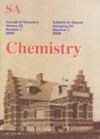金属铝上阳极氧化铝负载铂催化氢燃烧
IF 1
4区 化学
Q4 CHEMISTRY, MULTIDISCIPLINARY
South African Journal of Chemistry-Suid-Afrikaanse Tydskrif Vir Chemie
Pub Date : 2022-01-01
DOI:10.17159/0379-4350/2022/v76a06
引用次数: 2
摘要
实施催化氢燃烧(CHC)可以减轻对固体燃料燃烧的依赖,通常在撒哈拉以南非洲使用作为一种加热手段。然而,用于制造催化剂的低成本和容易获得的材料相对来说尚未开发。考虑到通常用于CHC的铂族金属的经济限制,必须最小化支撑材料及其作为催化剂载体的功能化成本。通常,诸如碳化硅泡沫、挤压氧化铝基陶瓷和氧化钛网/烧结板等材料用于承受与CHC相关的高温。本文采用高纯度(>99%)铝(Al)阳极氧化法制备了纳米结构的阳极氧化铝(AAO)作为载体材料。紧密粘附在金属铝芯上的AAO层充当热导管,将热量分散到整个催化剂中。作为活性金属的铂(Pt)以直径约19.3 nm的纳米颗粒沉积在AAO上。CHC反应在Pt/AAO催化剂表面自发进行。燃烧温度为408±18℃,氢气流量为100正常(N) mL min - 1,燃烧时间为70 h。pt颗粒的粒径明显增大(从19.3 nm增加到25.0 nm),但在70 h CHC过程中,其显著性不明显。本文章由计算机程序翻译,如有差异,请以英文原文为准。
Catalytic hydrogen combustion using platinum supported on anodized aluminium oxide adhered to metallic aluminium
The implementation of catalytic hydrogen combustion (CHC) can mitigate the dependence on solid fuel combustion typically used in SubSaharan Africa as a means of heating. However, low-cost and readily available materials for catalyst fabrication are relatively unexplored. Considering the economic constraints regarding platinum group metals generally used for CHC, the cost of support materials and its functionalization as catalyst support has to be minimized. Typically, materials such as silicon carbide foam, extruded aluminium oxidebased ceramics, and titanium oxide mesh/sintered plates are used to withstand the high temperatures associated with CHC. In this paper, nanostructured anodized aluminium oxide (AAO) was synthesized as the support material via the anodization of high purity (>99%) aluminium (Al). The AAO layer intimately adhered to a metallic Al core acted as a thermal conduit to disperse heat throughout the catalyst. Platinum (Pt), considered as the reactive metal, was deposited to the AAO as nanoparticles with a diameter of approximately 19.3 nm. The CHC reaction proceeded spontaneously on the surface of the Pt/AAO catalyst. A combustion temperature of 408 ± 18 °C was maintained for 70 h at a 100 normal (N) mL min−1 hydrogen flow rate. The Pt-particles showed a relatively appreciable increase in particle size (from 19.3 nm to 25.0 nm), but the significance thereof was not evident during the 70 h CHC procedure.
求助全文
通过发布文献求助,成功后即可免费获取论文全文。
去求助
来源期刊
CiteScore
3.10
自引率
0.00%
发文量
6
审稿时长
>12 weeks
期刊介绍:
Original work in all branches of chemistry is published in the South African Journal of Chemistry. Contributions in English may take the form of papers, short communications, or critical reviews.

 求助内容:
求助内容: 应助结果提醒方式:
应助结果提醒方式:


